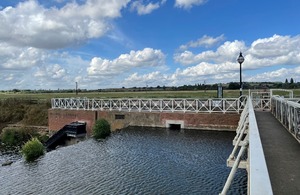Critically endangered European eel given hope for the future
The Environment Agency’s work to improve eel passage at the confluence between the River Avon and River Severn at Tewkesbury, Gloucestershire is now complete.

One of the new Environment Agency eel passes
- Environment Agency project to help combat the decline in European eels
- Two new eel passes at confluence of River Avon and River Severn at Tewkesbury give critically endangered eel a chance to complete their life cycle
- 26.7 km of River Avon and its tributary Carrant Brook opened up for eels to migrate
The construction of two new eel passes at the Stanchard Pit weir and the Abbey Mill sluice has opened up a 26.7km passage on the River Avon and its tributary Carrant Brook for the migration of the critically endangered species.
Construction of the eel passes began in September 2021. The Stanchard Pit eel pass was completed in October 2021 while construction of the Abbey Mill eel pass, which started in March 2022, was completed earlier this year. Further work to reinstate the landscape to its former pre-construction state is now taking place.
Eels are an important part of the water environment. They feed on invertebrates, fish, molluscs and crustaceans, helping to recycle nutrients and are an important food source for many species. The European eel has an extraordinary life cycle. Adult eels spawn in the Sargasso Sea on the other side of the Atlantic Ocean and larvae return on ocean currents towards the coasts of Europe and North Africa.
The European eel enters rivers and lakes and spends anything from 5 to 20 years feeding and growing into adult eels. It then returns to sea as a ‘silver eel’ and swims over 3500 miles back to spawn in the Sargasso Sea.
Patrick O’Donnell, Project Manager for the Environment Agency, said:
“To comply with the Eels (England and Wales) Regulations 2009, we had a legal obligation to provide eel passage at Abbey Mill sluice and Stanchard Pit weir as these two structures are the first obstructions to eel passage on the River Avon.
“Delivering the two new eel passes will provide effective eel passage at both these sites to allow the safe migration of eels into the river systems, to complete their life cycle.
“As the Abbey Mill sluice is located close to the Grade II-listed Abbey Mill, we needed to minimise the visual impact of the eel pass, while still maintaining a fully functioning passage for the European eel.”
The River Severn, the Mill Avon and River Avon are migratory routes for European eel which is a protected species. Over the last 30 years, the number of juvenile eels returning to rivers has fallen by around 95% across Europe and, consequently, the International Council for the Exploration of the Sea (ICES) advises that ‘the stock of European eel is outside safe biological limits.
Further information
The Environment Agency has recently carried out new research to enable a better understanding of the life cycle of the critically endangered European eels and how to combat their decline:
The Environment Agency is responsible for the Abbey Mill Sluice and Stanchard Pit Weir, on adjacent channels of the River Avon, maintaining them for navigation and river level management purposes.
The Environment Agency is the lead authority in England for the protection of eels. We have powers to seek action at barriers to migration (eel passes or barrier removal) and at water intakes (including eel screens and fish friendly pumps). We have already secured improvements at around 1000 sites across England. More are planned in coming years.
The project to construct the two new eel passes has cost £2.2 million The area in which they are situated is close to the Severn Ham Site of Special Scientific Interest, which is one of the last remaining traditionally managed flood meadows. This large open area is as much part of Tewkesbury`s history and heritage as the Abbey that overlooks it.
No trees were cut or removed for the installation of the eel passes. Protection and improvement works were also done in collaboration with the Severn Trent Water project on the Severn Ham. This was to minimise the impact and reduce the overall construction programme in delivering both eel pass projects.
Increasing connectivity for fish also supports the 2015 Severn River Basin Management Plan’s (RBMP) aim for waterbodies to achieve good ecological status or potential by 2027. It will contribute to improving the status of eel as a designated feature of the Severn Estuary Special Area of Conservation.